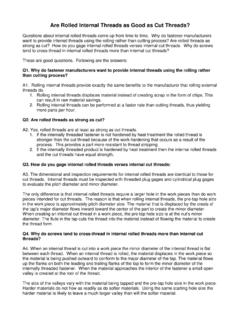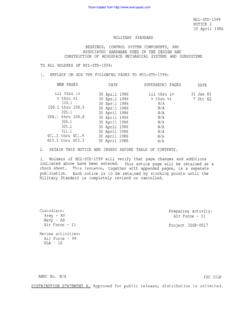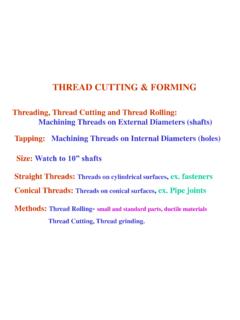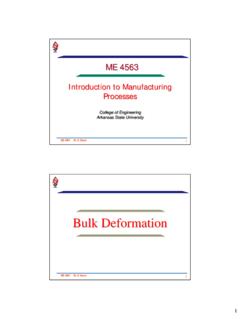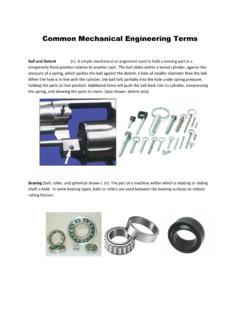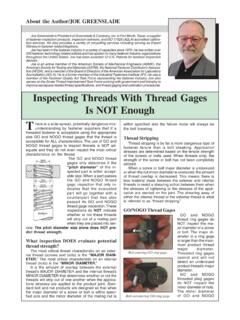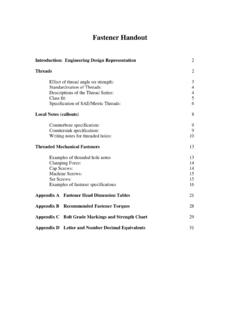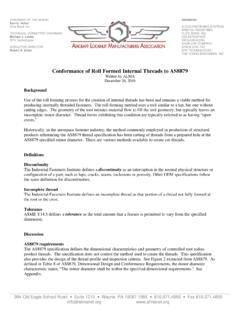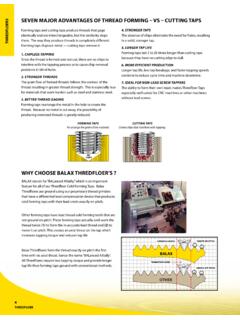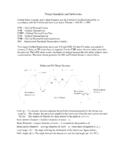Transcription of Comprehensive Study of Cut and Roll Threads - IOSR Journals
1 IOSR Journal of Mechanical and Civil Engineering (IOSR-JMCE) e-ISSN: 2278-1684,p-ISSN: 2320-334X, Volume 11, Issue 2 Ver. VI (Mar- Apr. 2014), PP 91-96 91 | Page Comprehensive Study of Cut and Roll Threads Darshith. S1, Ramesh Babu K2 and Manjunath S S3 [1, 2]Dept. of PG studies, Govt. Tool Room & Training Centre. Mysore-16, Karnataka, India [3]Dept. Mechanical Engg. Govt Engg college. Haveri. Karnataka, India Abstract : In the competitive world, it is very much necessary to design a new product to sustain in the industry. The main component in any assembly is fasteners, development of Threads are continues from the old steel age era, still today this process is on and the utilization of Threads for providing positive clamping is the key factor.
2 Screw Threads are designed to perform transmission of power and motion, it should act as fastener. The most commonly used Threads are British Whitworth, unified Threads , square Threads , acme Threads , knuckle Threads and buttress Threads . This paper deals with the thread cutting and thread rolling process for special Threads . The various methods of thread cutting and thread rolling process are discussed. The selection of blank diameter for thread cutting and rolling process and the advantages of thread rolling process over the thread cutting process will elaborate the qualities of rolled and cut Threads . Keyword: Blank diameter, cut Threads , rolled Threads , thread cutting and thread rolling . I. INTRODUCTION The screw was discovered by the Archimedes of the Greek colony about 256 Leonardo da Vinci further developed it and from it evolved the principle of the screw propeller, but it did not receive any practical application until many hundreds of years.
3 Some of the early uses of the screw thread were its application to the instruments of torture employed by the Inquisition, to baling or compressing devices and to the earliest attempts at printing. A descendant of the latter still exists in the form of the old style letter-copying press. So far as is known, the first method of threading a screw was to forge a blank, upset one end to form the head and then cut the thread by filing. Beson (France, 1569) invented a screw-cutting gauge for the lathe which was used in practically the form it originated until 1841, when an Englishman (Hindley of York) improved upon it. Hindley's invention was used for many years by watchmakers for producing small screws. A hand-operated machine for producing screws was invented in 1836 by an American and was superseded in 1848 by an automatic machine, but both of these machines were designed for the production of wood screws [7].
4 Threaded components are generally used in assemblies when a load-bearing connection that can be disassembled without destructive methods is required in a design. The mechanical performance of such components, and of the assemblies in which they are used, is determined through evaluation of properties such as axial or tensile strength, torsional strength, shear strength, resistance to vibration loosening, fatigue resistance, resistance to thermal cycling, and hydraulic pressure integrity [3]. The mechanical properties of screw thread are depend on the method of manufacture and material of the blank used for the production of the thread . In generally external Threads of mechanical components can be produced through two manufacturing processes: turning and forming.
5 rolling is the most common method of forming external Threads and this method is called thread - rolling [8]. The thread cutting is the process of production of larger diameter and non- uniform Threads . II. Manufacturing thread rolling The thread rolling is simple cold forging operation. In this process the blank is passed between the dies and shaped into a threaded component. The plastic deformation is depends on the material s yield strength and its percentage of elongation. To be rollable, a given material should have an elongation factor of 12%. Other influencing factors are hardness, its microstructure, and the degree and speed at which it work hardens. Also, its modulus of elasticity, the non-metallic content of steels, and the workpiece diameter and pitch. Strength of rolled thread is more when compared to cut thread .
6 [10]. The smoothness and uniformity of rolled thread is good when compared to the cut thread [5]. There is no shearing in thread rolling process and thread formed in rolling process is having required cross section, hence it eliminate any secondary operation.[4]. Comprehensive Study Of Cut And Roll Threads 92 | Page thread rolling dies Hardened steel dies are used to roll the Threads such as Halcomb 218 (Crucible), Potomac A (Allegheny), AISI 610 0, Vascojet 100 (Vanadium Alloys) [10]. The threaded faces of these dies are pressed against the periphery of plain cylindrical blank and re-form the surface of the blank into Threads as the blank rolls on the die faces. The blank has a diameter part way between the major and minor diameter of the thread .
7 The most of thread rolling operation is carried out in room temperature and the blank temperature will be normal. The Threads produced by the rolling process are having high physical qualities such as uniform surface and precise Threads . The depth of penetration will be maximum in entrance of the die [5]. The figure 1 shows the typical flat thread rolling die. The working faces of the dies have a thread form which is reverse of the thread to be produced. In penetration the surface of the blank, the dies displace the material to form the roots of thread and force the displaced material radially outward to form the crests of the thread . The equipment and tool used for thread rolling is depends on the nature of the part, the type and specification of Threads . The equipment used for thread rolling can be classified as [1] Reciprocating (flat-die) machines [2] Rotary planetary machines [3] Cylindrical die machines Reciprocating (Flat- die) machines The figure 2 shows the flat die mechanism.
8 In reciprocating type the two flat dies are used, they are stationary die and moving die, the rolling faces of the dies are situated opposite to each other. The thread is rolled on the blank in the forward stroke of machine. Rotary planetary machines The rotary planetary die mechanism is explained in the figure 3. This consists of a rotating circular die and stationary die. The blank is fed between the rollers at the initial moment, after which it rotates and moves in an axial direction by itself. The tool equipment, together with the blank, has a kinematic scheme of a planetary mechanism and therefore, the tool equipment will be called a planetary thread - rolling head [2]. In rotary planetary machines one central rotary die on a fixed axis and stationary concave segment dies located to the outside of the rotary die.
9 The thread - rolling process with planetary head belongs to so-called axial rolling [2]. Cylindrical die machines In cylindrical die machines, the blank is rolled between the two cylindrical rolling dies in the opposite direction. The thread rolling process is the fastest method of producing Threads , the thread rolling machine maybe manually loaded or automatically loaded. The thread rolling dies do not require sharpening, therefore down time is reduced and sharpening and resetting labor is saved. The cylindrical die mechanism can be classified as [1] Two rollers die [2] Three rollers die The figure shows the standard two rolling dies. They are placed in 1800 to each other. These rollers are incapable of rotating in its axis. Figure shows the direction of rotation. For the formation of Threads these rollers rotate in opposite direction to each other.
10 The figure shows the distinctive three rolling dies. They are placed in 1200 to each other. These rollers are having four degrees of freedom. Figure shows the direction of rotation. The rollers are accomplished with rotating in uniform speed. thread CUTTING The thread cutting operation can be carried out in conventional lathe/CNC. The blank is loaded to machine and turned. The form tools or single point cutting tools are used in this operation. The large diameter and non standard Threads are produced. Threading dies are the parts on which teeth are formed for cutting the screw Threads , either external or internal. These parts are also properly called chasers. The distinction is often made of calling them dies when referring to those for external Threads , and chasers when for internal Threads [7].










